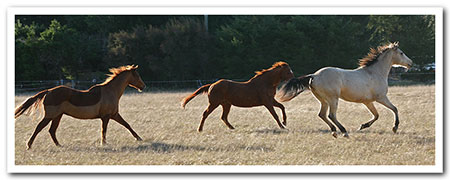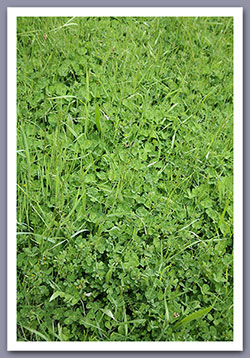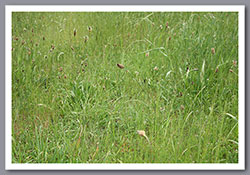Nitrogen and Clover
Horses thrive on rough unfertilised pasture as in this picture.
There is no clover in this and it hasn't been fertilised in many many years if at all.
As you can see, all these horses whose ages range from 2 years to 31 years are doing beautifully. This what our horses should be grazing!
Understanding Nitrogen for Horses vs Ruminants.
The last couple of Facebook posts have generated great discussions and clearly we need to explain why we don’t want to apply nitrogen (either in the form of nitrogen fixing plants such as clover or any of the fertilisers like NPK or Urea (which is nitrogen)).
Plants cannot utilize nitrogen per se, instead it is converted into the soluble nitrate which latches onto potassium and goes up into the plant with water. (Hence pastures are more problematic after rainfall). The animal therefore ingests the potassium nitrate.
Excess nitrates accumulate in plants when they are stressed especially when over-grazed. Drought or hot dry winds (Eeek, that’s us here in Canterbury!) put forage under water stress often resulting in nitrate accumulation. Hail or frost damage interferes with the process of photosynthesis also resulting in excess nitrates. A row of cool cloudy days can do the same.
When the night time temperatures are too low for growth or there is another limiting factor as above, nitrates accumulate in the lower portion of the stems and sugars are stored in the leaves.
Those wide leaves of ‘Broad leaf’ plants provide plenty of space to store sugars as starch. Starch is very easily digestible (and therefore not good for most horses), rye-grass is not only a known nitrate accumulator but it also stores sugars in chains known as ‘fructans’ which are not good for horses either as they (horses) don’t possess the enzyme to break them down. Grasses vary in the amount of starch and fructans they contain according to the climatic conditions.
Ruminant animals possess microbes which incorporate nitrogen into protein molecules within the rumen, the rest is converted to ammonia by the liver and excreted as urea in the urine.
Horses CANNOT utilize nitrogen in this way because they don’t have a rumen or the microbes. Nitrates still need to be excreted – however, the process of excreting excess nitrates (anions) robs the horse of precious calcium and magnesium (cations) which is a major contributor to horses becoming ‘Grass Affected’.
(See the Health Check)
Horses in their natural habitat thrive on plants growing on unfertile land.
Think Twice Before Fertilising!

This is a classic example of what can happen when you take advice from someone who comes from a farming perspective rather than a horse perspective. It is what can happen when you apply some of these ‘lifestyle block’ fertilisers.
The motivation to fertilise part of this property was to increase the volume of the hay crop. On advice from a farming Rep, ‘Nutrigro’ was applied to the hay paddock. You can see the result (the photo on the left was exactly the same land which wasn’t fertilised). The addition of Nutrigro (which by the way also contains selenium) boosted the growth of clover to the point it has become prevalent over the grass – the very thing we don’t want!
The trouble is, now these people will have to sell this hay and buy in hay that will be more suitable for her already laminitic prone horses. A considerable hassle with clover free hay being in short supply!
If we had known earlier, it would have been possible to use a broadleaf spray to eliminate the clover and then this hay would have been 100% grass and therefore not such a problem.
Clover is not part of any horse’s natural diet and will cause your horse no end of trouble from laminitis to head-shaking, not to mention reproductive problems! We can’t stress it enough, horses need grass not legumes and it needs to comprise low nutrient density fodder. (IE: Rough, high fibre hay made from grasses growing on UNFERTILE ground)

This grass is on the same the land as the grass above
but wasn't fertilised
*Be very careful about fertilisers that contain selenium – too much selenium in the diet is as dangerous as too little. Adding selenium to the soil means you never know how much the horse is actually getting – it starts out with plenty and it dwindles over time. This is why it is better to add it daily to feeds. Premium NZ Horse Minerals or MVA both contain the correct amounts of selenium so you don’t have to worry about your horse being deficient or getting too much.
Spraying the Clover Out
Cathy had her paddocks sprayed out for clover at the beginning of October.
Here is the before - and after taken at the beginning of December...


Now that clover is no longer in competition with the grass, the grass can grow thicker than ever. No extra grass was sowed here and NO fertiliser was applied.
Why you need to prevent your horse eating Autumn Grass Shoots:
The other day I crawled around on hands and knees for an hour to pick a big enough sample of these fresh autumn grass shoots to send away to be analysed.

The results came back a few days later:
- High potassium (3.4%) low sodium (0.138%) Translates to a stress on the horse to excrete the excess potassium and conserve sodium (as this is not enough to run the metabolism of the horse) Hence the recommendation to add salt to feeds.
- High Nitrates (nearly 1700 mgs/kg which translates for a LOT when the horse grazes all day!) The process of excreting these excess nitrates uses up valuable calcium and magnesium. Eliminating the nitrates by avoiding your horse eating this very potent grass is the far safer option.
- A very high DCAD (494) when ‘Under 200’ is what is thought to be in the safe range for horses. You can’t feed enough salt and GrazeEzy to balance a DCAD as high as this! The DACD is the Dietary Cation Anion Difference which means the difference between the number of positive ions (mainly potassium) to negative ions (mainly chloride)
My veterinarian friend says she regularly sees DCAD’s as high as this and higher from analyses of dairy pasture. - Interestingly the sugars were only 15%, still too high for laminitis prone horses and ponies but not nearly as high as some hay I have seen which was 23%.
You can see why sugars are only one aspect of pasture that can adversely affect your horse.
Shoots like this can pop up quickly in Autumn (and Spring) and represent a sudden change in diet for the horse if he is left out there to graze them without supplementary roughage and appropriate minerals being added to his rations. Consuming such unbalanced grass without ‘help’ can be disastrous for health and behaviour especially those equines prone to laminitis and head-flicking.

 Calm Healthy Horses
Calm Healthy Horses